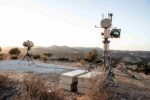The U.S. Army is reportedly considering testing a new wheeled variant of Hanwha Aerospace’s K9A2 Thunder self-propelled howitzer — a platform that could reshape future artillery force structures by combining proven firepower with enhanced mobility and lower lifecycle costs. The move signals growing U.S.-ROK defense cooperation and reflects the Pentagon’s interest in more agile long-range precision fires.
Hanwha’s Wheeled K9A2: A New Chapter in Mobile Fires
South Korea’s Hanwha Aerospace has developed a wheeled version of its combat-proven K9A1/A2 Thunder 155mm/52-caliber self-propelled howitzer to meet evolving global demand for highly mobile artillery systems. While the tracked K9 has seen widespread adoption — including by NATO members such as Poland, Norway, Estonia, and Finland — the new wheeled variant aims to offer comparable firepower with reduced operating costs and improved road mobility.
The wheeled prototype was first unveiled at DX Korea 2022 and later showcased at AUSA 2023 in Washington D.C., where it drew interest from multiple international delegations. The platform integrates the fully automated turret and fire control system from the tracked K9A2 onto an 8×8 chassis derived from the Hyundai Rotem KW1 (also used in South Korea’s M3 amphibious bridge system), offering high-speed road maneuverability while retaining compatibility with NATO-standard 155mm ammunition.
Key features include:
- 155mm/52-caliber gun with autoloader (up to 10 rounds per minute)
- Range exceeding 40 km with standard HE projectiles; up to ~60 km with rocket-assisted rounds
- Automated fire control system compatible with NATO C4I networks
- Reduced crew size (3–4 personnel)
- 8×8 high-mobility chassis capable of speeds over 90 km/h on roads
U.S. Army Interest Tied to Strategic Mobility and Cost Efficiency
The U.S. Army has not formally confirmed procurement or testing plans but is reportedly evaluating several next-generation mobile artillery platforms under its Extended Range Cannon Artillery (ERCA) and broader Long-Range Precision Fires (LRPF) modernization efforts. While ERCA focuses on extended-range tracked systems like the XM1299 Paladin upgrade, there is growing interest in complementary wheeled systems that offer faster road deployment and lower sustainment costs for lighter formations such as Stryker Brigade Combat Teams (SBCTs).
The potential testing of Hanwha’s wheeled K9A2 aligns with these goals. In particular:
- Wheeled systems reduce logistical burdens compared to tracked SPHs
- Faster road speeds enable rapid repositioning for shoot-and-scoot tactics
- Simplified maintenance footprint suits expeditionary operations
This would not be Hanwha’s first entry into U.S. evaluations; its Redback IFV was shortlisted for Australia’s LAND400 program and shares commonality with many NATO systems. Moreover, Hanwha Defense USA has expanded its presence in Georgia and Alabama to support local production — a key factor if any future Foreign Military Sales (FMS) or Foreign Comparative Testing (FCT) opportunities arise.
K9 Platform Evolution: From Tracked Dominance to Wheeled Flexibility
The original K9 Thunder entered service with the Republic of Korea Army in the late 1990s as a response to North Korean artillery threats along the DMZ. Designed by Samsung Techwin (now Hanwha Aerospace), it quickly became one of the most successful modern SPHs globally due to its robust performance and modularity.
The current K9A1 variant includes digital fire control upgrades and GPS-based navigation; meanwhile, the K9A2 introduces full automation via autoloaders and remote turret operation — reducing crew workload while increasing rate-of-fire consistency under combat conditions.
Variants include:
- K10 ARV: Automated resupply vehicle integrated into fire units for sustained operations
- K11 FDC: Fire direction center vehicle coordinating battery-level targeting
- K9 VIDAR: Norwegian cold-weather optimized version with rubber tracks
The shift toward a wheeled version reflects both export market dynamics — where some nations lack heavy tracked logistics infrastructure — and doctrinal shifts emphasizing dispersed fires across larger operational areas.
NATO Interoperability and Export Potential Beyond Asia-Pacific
The wheeled K9A2 could appeal not only to U.S. forces but also European armies seeking replacements for aging M109s or CAESAR-style truck-mounted guns without sacrificing armor protection or rate-of-fire advantages.
Countries like Romania, Spain, or even Baltic states may find value in a hybrid solution offering better survivability than truck guns but greater mobility than legacy tracked assets. Poland already operates over 120+ domestically built Krab SPHs based on the original K9 chassis mated with a British AS-90 turret — showcasing deep industrial cooperation potential.
If adopted by even limited U.S. formations or tested under FCT protocols, it would significantly boost confidence among other NATO buyers wary of committing to non-U.S.-origin platforms absent American endorsement.
Tactical Implications for Indo-Pacific Deterrence Posture
A forward-deployable wheeled SPH like this could enhance U.S.-ROK-Japan trilateral deterrence posture against regional threats such as North Korean massed artillery or Chinese anti-access strategies across island chains.
A mobile fires platform that can rapidly reposition across austere Pacific islands or respond quickly within Korean terrain offers clear value when paired with counter-battery radars like AN/TPQ-53 or battlefield ISR drones feeding real-time targeting data into digital fire networks.
This also dovetails with emerging Multi-Domain Task Force (MDTF) concepts where long-range precision effects are synchronized across air-land-sea-cyber domains using agile platforms able to survive first strikes through dispersion rather than armor alone.
Outlook: From Concept Demonstration to Potential Procurement?
No formal request-for-information (RFI) or contract has been issued yet by the Pentagon regarding this specific variant; however, industry observers expect either an FCT trial or limited user evaluation as early as FY2026 depending on funding availability under PEO Ground Combat Systems initiatives.
If successful during trials — particularly under contested electromagnetic environments or rapid redeployment scenarios — it could open doors not just for procurement but also co-production agreements leveraging Hanwha Defense USA facilities already established on American soil.
This would mark another milestone in Seoul-Washington defense industrial ties following recent joint ventures on missile defense interceptors (L-SAM derivatives), counter-UAS systems, and naval propulsion technologies under ROKN-USN collaboration frameworks.










